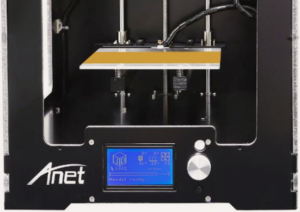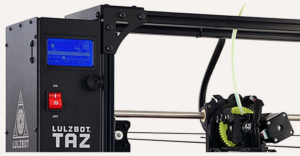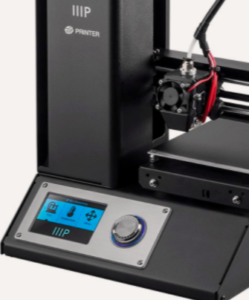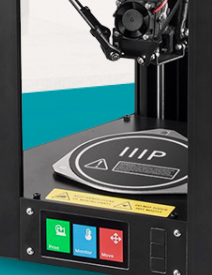When releasing a new 3D printer model, manufacturers wonder what screen they should put in their printers. Let’s discuss what features make a good screen and what options manufacturers have:
Many desktop 3D printers still come with monochrome LCDs. When I see them, it makes me think we are in the 80s. But seriously, do we really think that the average customer will want to buy a 3D printer with that display? Today, 3D printers are the only piece of technology that comes with such an antiquated user interface.
- Companies such as Anet and LulzBot still use old screen displays
Luckily, many 3D printer manufacturers are realizing that it’s not just about print quality & speed. Users need to have a nice interaction with the printers. A good screen, with the right software technology, gives the printer a better look and enormously improves the user experience, making the machine look easier to use and more approachable.
A first level of improvement that some companies are taking is to invest in a better screen UI while still maintaining the knobs and external buttons. Monoprice is a good example of this. Their Maker Ultimate comes with the old monochrome display, their Monoprice Mini (their best selling printer) comes with a nicer UI with a knob, and their newest printer, the Delta Mini, comes with a full color screen and external buttons. While these are significant advances, they still lack the nice natural feeling of a touchscreen. According to user reviews, the Delta Mini “makes you want to touch the screen,” which is frustrating to the user since the screen is not touch enabled.
- Monoprice Maker Ultimate
- Monoprice Mini
- Monoprice Delta Mini
The next level of improvement is to go with a touchscreen. People need that touch feel. It’s much more intuitive and it’s how people interact with their phones, tablets, etc. Even 2D printers now come with touchscreens.
Robo3D and Craftunique are good examples of companies using touchscreens to make their printers more user-friendly. Raise3D is taking this to the next level using a more sophisticated software. The idea is that once you upload files to the printer, you can easily organize them, control and monitor the print directly from the touchscreen.
But what if you didn’t need a computer or SD card to print? That would be the next level of touchscreen functionality. XYZprinting aims to reach this level of user interactivity with its da Vinci 1.1 plus. The printer features a built-in gallery of downloadable designs to print; this allows the user
to download and print models directly from the touchscreen.
The downside of this printer is that you are limited to print what’s in their gallery. But, what if you could print anything directly from the touchscreen? Like having access to third party model repositories such as Thingiverse or MyMiniFactory. What if users could install apps on the printer as easily as they do on their phones? That would be the ultimate level of touchscreen software and I believe it is where the industry is heading. Printers gain value if they are connected to printable content and having the ability to do that directly from the printer screen significantly decreases the learning barrier it takes to get something from STL to physically in hand.
What Can 3D Printer Manufacturers Do?
While a superior touchscreen makes a better printer, it’s easier said than done. Most 3D printer manufacturers don’t have the software expertise or the resources to develop and maintain a good touchscreen software, not to mention one with user-friendly UI and connected to third party content. It takes time and money. These extra costs need to be passed on to the customer to maintain margins and sometimes manufacturers compromise the quality of the hardware for putting efforts in the software. This explains why some manufacturers still use the horrible monochrome display.
One large scale manufacturer we spoke to told us that to build their own cloud-connected touchscreen software (with mobile apps, web portal, and other bells/whistles) would take them three years and cost at least $3M in software engineering costs. Then of course, they would be three years behind other software providers that were innovating the whole time.
The 3D printing industry is maturing and manufacturers now have other alternatives than building their own software from scratch. AstroPrint just launched what might become the new standard. A touchscreen software that any manufacturer can instantly embed in their printers for a fraction of the typical development costs. This software is easily customizable to the specific hardware needs of the manufacturer.
This new option completely turns things around. For manufacturers that haven’t invested many resources in software, it becomes a no brainer since it allows them to instantly leapfrog competing 3D printers in terms of software technology. Similar to how phone manufacturers instantly ship their phones with Android OS, avoiding the large capital investments needed to develop their own OS.
For companies that have already invested enough resources, it becomes a difficult decision. These manufacturers have used software as their competitive advantage but they will now have to determine if it makes sense for them to continue to spend resources in software development while other companies ship their printers with cutting-edge software technology at low cost.
Some of them will continue to make their own software stacks but given examples of more mature technologies (+85% of phones come with Android. +90% of computers come with Windows), almost all 3D printer manufacturers will eventually adopt a standard OS to focus their energy on hardware, not software. The collaboration between hardware and software companies is what really unlocks the potential of desktop 3d printers.
Once thing is sure: the old monochrome display will be dead in no time.
Discuss this and other 3D printing topics at 3DPrintBoard.com or share your thoughts below.
Raul De Frutos is the Business Development Manager for AstroPrint.
Subscribe to Our Email Newsletter
Stay up-to-date on all the latest news from the 3D printing industry and receive information and offers from third party vendors.
You May Also Like
Precision at the Microscale: UK Researchers Advance Medical Devices with BMF’s 3D Printing Tech
University of Nottingham researchers are using Boston Micro Fabrication‘s (BMF) 3D printing technology to develop medical devices that improve compatibility with human tissue. Funded by a UK grant, this project...
3D Printing Webinar and Event Roundup: April 21, 2024
It’s another busy week of webinars and events, starting with Hannover Messe in Germany and continuing with Metalcasting Congress, Chinaplas, TechBlick’s Innovation Festival, and more. Stratasys continues its advanced training...
3D Printing Webinar and Event Roundup: March 17, 2024
It’s another busy week of webinars and events, including SALMED 2024 and AM Forum in Berlin. Stratasys continues its in-person training and is offering two webinars, ASTM is holding a...
3D Printed Micro Antenna is 15% Smaller and 6X Lighter
Horizon Microtechnologies has achieved success in creating a high-frequency D-Band horn antenna through micro 3D printing. However, this achievement did not rely solely on 3D printing; it involved a combination...





































